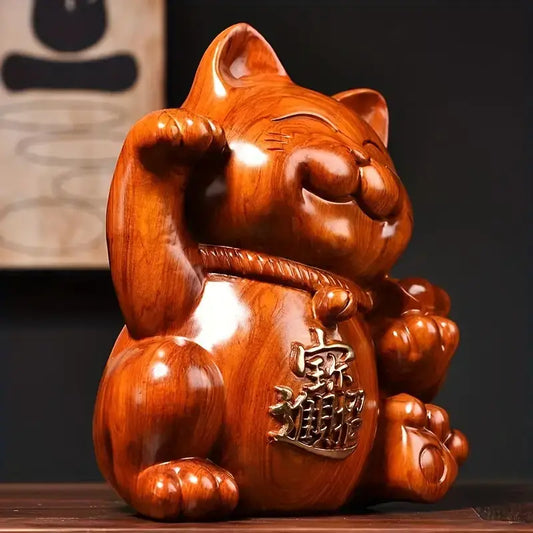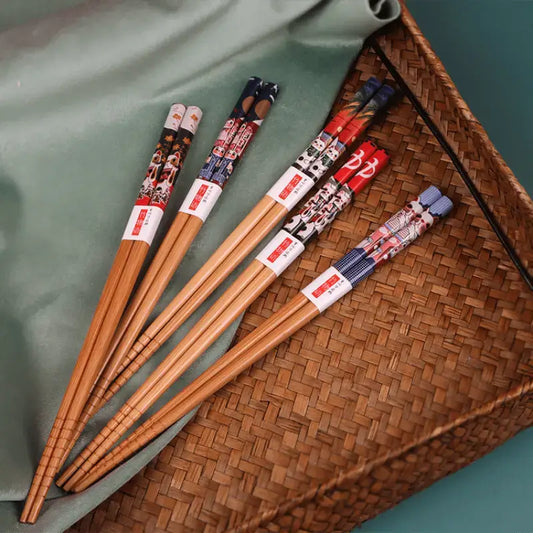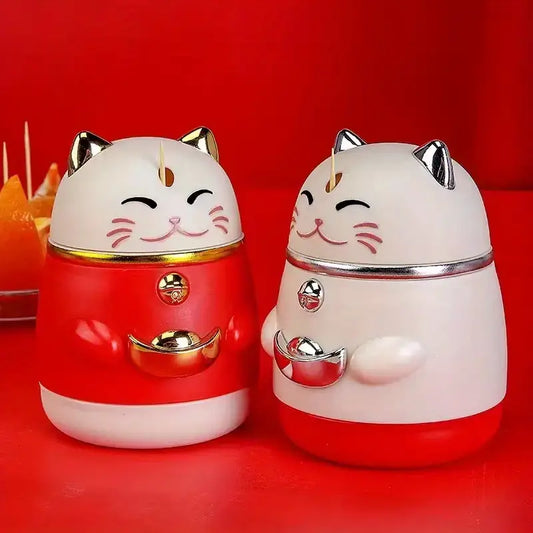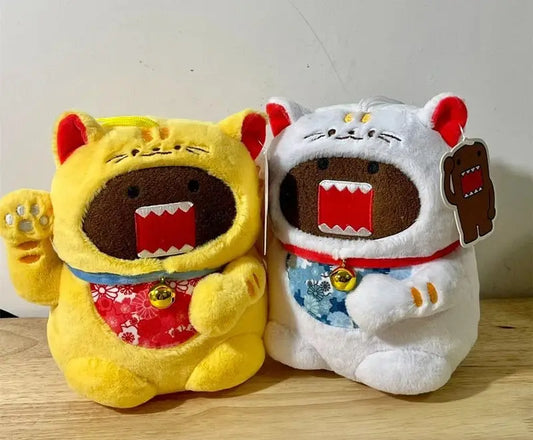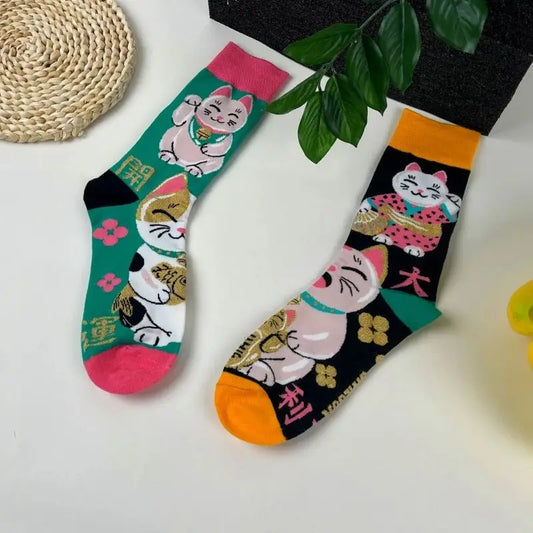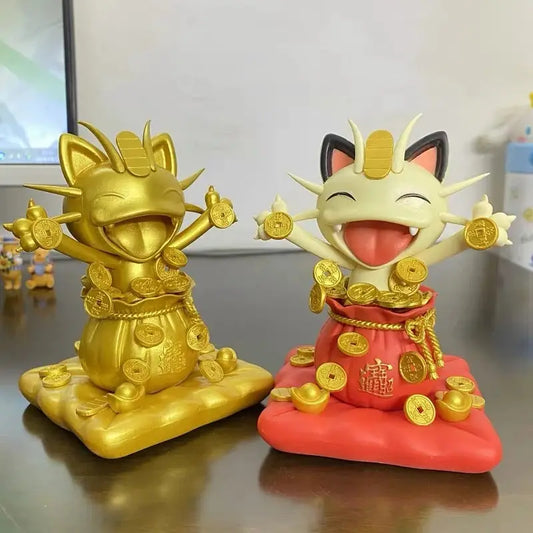Welcome to the Magical World of Maneki Neko 🌟🐾
Step into a world where tradition meets charm, where ancient symbolism fuses with contemporary design, and where good fortune is more than just a hope—it's a promise 🚀. Welcome to our Maneki Neko online collection, the ultimate haven for those enchanted by the beckoning cat — a legendary Japanese icon known across the world for its ability to attract luck, wealth, and joy ✨😺. Whether you're a passionate collector, a cultural enthusiast, or someone simply seeking a sprinkle of magic in your home or business, you're in the right place 🏡.
Our curated selection of Maneki Neko figures is more than just a product gallery. It's a celebration of a spiritual tradition that spans centuries, wrapped in vivid colors, delicate craftsmanship, and universal positivity 🌟. From the classic gold cat waving in prosperity to modern pastel versions perfect for minimalist interiors, this page is your gateway to discovering everything about the Maneki Neko legend and finding the perfect feline talisman for your lifestyle 🌊.
The Story Behind the Beckoning Cat 😺🌟
To truly appreciate the Maneki Neko, you must first dive into its rich and captivating history ⏳. Originating in Japan during the Edo period (1603-1868), the Maneki Neko is steeped in folklore and ancient belief 🇯🇵. The name "Maneki Neko" literally translates to "beckoning cat," and it's traditionally depicted with one paw raised in a welcoming gesture 👋. But there's more than one legend behind this iconic symbol ✨.
One of the most well-known tales is the story of a poor temple priest and his loyal cat ⛪🐈. During a thunderstorm, a wandering samurai took shelter under a tree near the temple. He noticed a cat raising its paw toward him, as if beckoning ☘️. Curious, the samurai approached the temple just before lightning struck the very tree he had been standing under ⚡. Grateful for the cat's divine intervention, the samurai became a benefactor of the temple, bringing it prosperity 🌹. Thus, the image of a beckoning cat became synonymous with fortune and protection ✨💫.
In another variation, the Maneki Neko is seen as a symbol of commercial success 💼. Businesses started placing them in storefronts and windows to attract customers and wealth 📅. The raised left paw is said to bring in customers, while the right paw attracts money 💰. Today, Maneki Neko figures are made in a variety of colors, each with its own meaning—gold for wealth, white for happiness, black for protection, and even pink for love 🌟😺.
Maneki Neko Color Symbolism Table 🌈
| Color | Meaning | Ideal Placement |
|---|---|---|
| Gold | Wealth & Prosperity | Business counters, offices |
| White | Purity & Happiness | Living rooms, bedrooms |
| Black | Protection from Evil | Near doors, entryways |
| Pink | Love & Romance | Bedrooms, vanity tables |
| Green | Academic Success | Study areas, libraries |
| Blue | Career Advancement | Desks, workspaces |
Each color variation of the Maneki Neko tells a story, creating a deeper emotional connection and allowing collectors and enthusiasts to align their talisman with their personal goals and desires 🌿😍.
Why Maneki Neko is More Than Just a Cat 😺✨
At first glance, the Maneki Neko might look like a simple ornamental figure 🪩, but it embodies a profound blend of cultural symbolism, spiritual energy, and artistic design 🎨. Its popularity isn't just a result of its cute appearance — it has become a global emblem of positivity and hope, transcending language and borders 🌍.
The raised paw isn't just a gesture; it's a symbol of invitation 🙋. When a Maneki Neko lifts its left paw, it's inviting people and opportunities ✅. When it raises its right, it's calling in wealth and success 💸. The inclusion of other traditional motifs, such as koban coins (an old Japanese gold coin 🪙), bibs, bells, and decorative collars, adds layers of meaning to the statue 🔹.
Modern interpretations have allowed Maneki Neko to remain culturally relevant 🤝. From LED-lit versions that glow with fortune 🔦, to plush toys, to minimalistic ceramic pieces suitable for contemporary home décor 🛋️, this cat has shape-shifted into various forms without losing its essence 🐈. People place them in their businesses to attract footfall 🛍️, at home to welcome peaceful energies 💖, or gift them as heartfelt tokens of goodwill 🎁.
In essence, the Maneki Neko is a wish in solid form ✨✨ — a tangible reminder that good things are coming 🚀. Its silent beckon is both a guardian and a herald, a beacon of hope that fits neatly on your shelf 🪟.
Styling Your Maneki Neko: Elevate Your Space 🌟🌾
You don’t need to have a shrine or a commercial storefront to appreciate the aesthetic and spiritual value of a Maneki Neko ⛪️. Styling this symbol within your space is a creative and rewarding experience 🎨. The key lies in intention and placement 🔺.
For a modern minimalist home, a sleek white ceramic Maneki Neko with clean lines can serve as both a conversation piece and a spiritual anchor 📏. If your space is more eclectic, opt for a traditionally colored cat adorned with vibrant reds, golds, and greens to energize a bookshelf or corner table 🍃. Place your Maneki Neko near entryways to invite positive energy in, or next to your workspace to bring focus and prosperity 🏠💼.
Tabletop arrangements are a great way to create mini altars with your Maneki Neko ✨. Combine them with crystals 🪨, incense 🛶, or small plants 🌿 to enhance their energy. A golden cat surrounded by jade stones and a money tree plant, for instance, forms a powerful wealth-attracting setup 💰. You can also get playful and seasonal—decorate your Maneki Neko with miniature scarves in winter ❄️ or fresh flowers in spring 🌸.
Top Styling Combos 🌿💫
| Maneki Neko Style | Best Style Match | Vibe It Creates |
| White Ceramic | Minimalist, Scandinavian | Peaceful & Purifying |
| Gold Traditional | Asian-themed, Maximalist | Prosperous & Vibrant |
| Pastel Pink | Kawaii, Boho | Romantic & Playful |
| LED Lit | Futuristic, Tech-Inspired | Modern & Energetic |
| Wooden Carved | Rustic, Nature-Inspired | Grounded & Spiritual |
Experiment with heights 📏, textures, and background elements like framed prints 🌌 or soft lighting 🌞 to make your Maneki Neko feel like an intentional part of your interior design 🏡.
Perfect Pairings: What to Combine With Your Lucky Cat 🐈💫
Maneki Neko might be a solo star, but it shines even brighter when paired with complementary items 💚. Whether you’re building a prosperity altar, curating a shelfie, or crafting a personalized gift box 🎁, here are some perfect pairings to consider ✨.
Feng Shui Elements: Combine your Maneki Neko with Feng Shui coins 🪙, bamboo plants 🌿, or flowing water features 🌊. This creates a harmony of elements that amplifies the statue’s energy ⚖️.
Crystals and Gemstones: Citrine for abundance, rose quartz for love, and amethyst for clarity pair beautifully with Maneki Neko figures 🪨. Arrange these stones around your cat in a meaningful pattern 🌿.
Incense and Aromatherapy: Scents like sandalwood, jasmine, and patchouli elevate the spiritual aura of your Maneki Neko space 🛶. Light a stick of incense near the cat during meditation or before work for an intentional reset 🙏.
Lucky Charms & Talismans: Mix in other Eastern symbols like Daruma dolls 🧩, omamori charms 📖, or even origami cranes 💜. This not only enriches the visual story but also strengthens the energy of your space 🌾.
Combination Guide Table 🌿🌊
| Pairing Item | Purpose/Benefit | Placement Tip |
| Bamboo Plant | Growth & Flexibility | To the left of the cat |
| Citrine Crystal | Wealth Attraction | In front of the statue |
| Water Fountain | Flow of Prosperity | Behind the cat |
| Daruma Doll | Goal Setting & Persistence | Beside the Maneki Neko |
| Aromatic Incense | Purification & Intent Setting | On a tray beneath the cat |
When you blend the Maneki Neko with synergistic items, you're creating more than a display — you're building a personal altar to your dreams 🌟🤍.
Embrace the Fortune: Why Everyone Needs a Maneki Neko ✨😺
In a world that can often feel chaotic and unpredictable ⚡, the Maneki Neko offers a grounding symbol of optimism 🙏. It's not just for believers in mysticism or practitioners of Feng Shui 💡. The Maneki Neko belongs to anyone who believes in intention, energy, and the beauty of symbolic art 🎨.
Owning a Maneki Neko is like owning a tiny shrine of hope ⛪️🤍. It's the smile you see when you walk into your room 😊, the charm that greets your customers at the door 🛍️, the well-wish embedded into your personal space ✨. It tells the world, and reminds yourself, that luck isn't just about chance—it's about preparation meeting opportunity 🚀.
With so many styles, colors, and cultural layers to choose from, there is a Maneki Neko out there for everyone 😺. From luxurious gold porcelain pieces 🪑 to quirky glow-in-the-dark versions 🔦, each cat invites you into its world with a raised paw and a silent promise 🙋. So whether you're shopping for your home, your business, or a meaningful gift, remember: you're not just buying a statue. You're inviting a story, a symbol, and a source of daily inspiration into your life ✨.
And in a world where we could all use a little more luck, happiness, and charm, isn’t that something worth welcoming in? 🌟🌾



